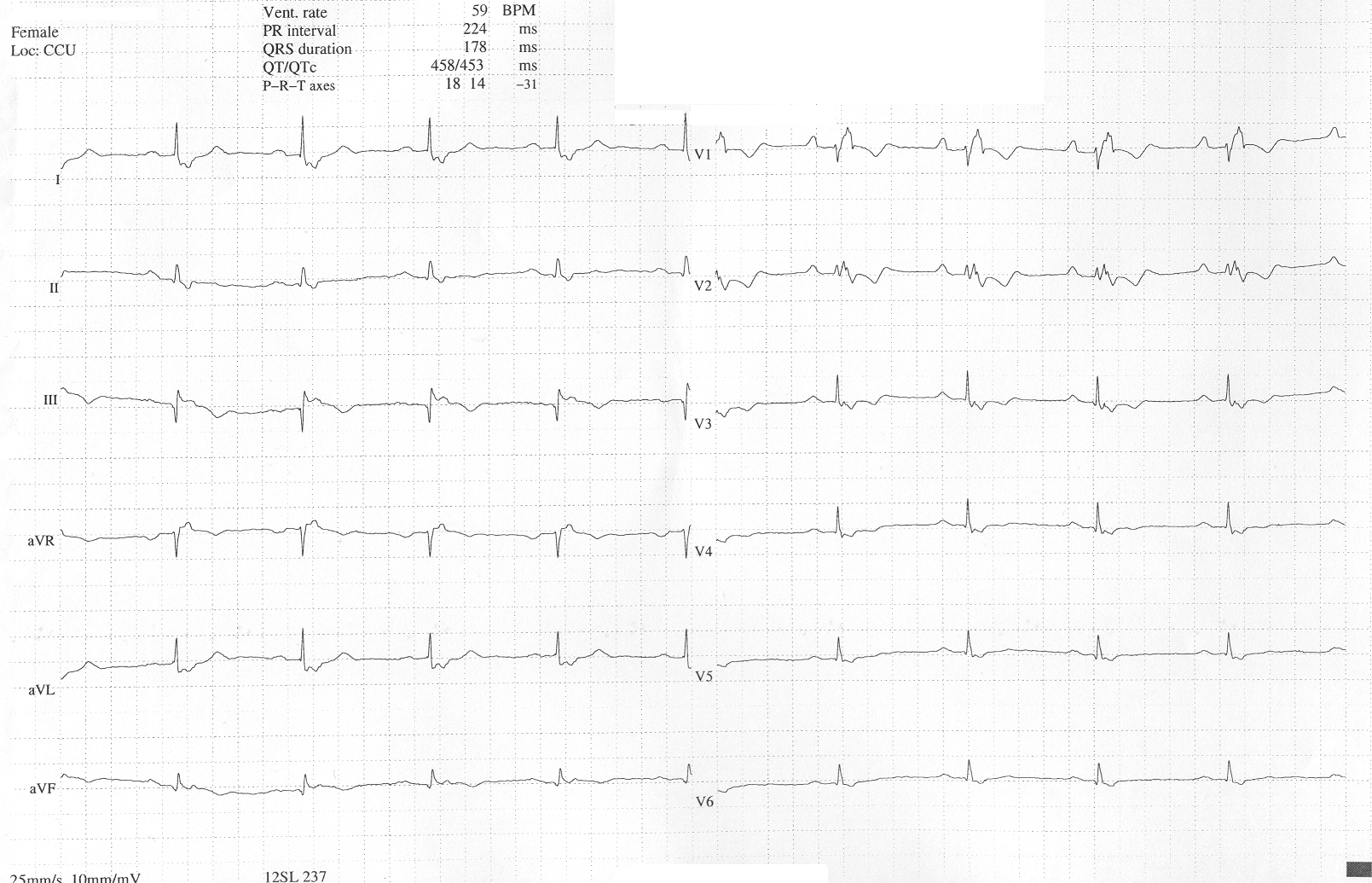Ebsteins anomaly of the tricuspid valve electrocardiogram: Difference between revisions
| Line 11: | Line 11: | ||
* [[First degree atrioventricular block]] due to an [[intraatrial conduction delay]] with a [[prolonged PR-interval]] | * [[First degree atrioventricular block]] due to an [[intraatrial conduction delay]] with a [[prolonged PR-interval]] | ||
* About 50% of individuals with Ebstein's anomaly have evidence of [[Wolff-Parkinson-White Syndrome]] (syndrome of [[pre-excitation of the ventricles]] due to an [[accessory pathway]] known as the [[Bundle of Kent]]), secondary to the the apical displacement of the septal tricuspid valve leaflet resulting in discontinuity of the central fibrous body. WPW has a left bundle branch pattern with predominant S waves in the right precordium | * About 50% of individuals with Ebstein's anomaly have evidence of [[Wolff-Parkinson-White Syndrome]] (syndrome of [[pre-excitation of the ventricles]] due to an [[accessory pathway]] known as the [[Bundle of Kent]]), secondary to the the apical displacement of the septal tricuspid valve leaflet resulting in discontinuity of the central fibrous body. WPW has a left bundle branch pattern with predominant S waves in the right precordium as well as a short [[PR interval]] and a [[delta wave]]. | ||
* [[Low amplitude QRS complexes]] in the right precordial leads, | * [[Low amplitude QRS complexes]] in the right precordial leads, | ||
| Line 18: | Line 18: | ||
* [[T wave inversion]] in V<sub>1</sub>-V<sub>4</sub> and [[Q waves]] in V<sub>1</sub>-V<sub>4</sub> and II, III and aVF. | * [[T wave inversion]] in V<sub>1</sub>-V<sub>4</sub> and [[Q waves]] in V<sub>1</sub>-V<sub>4</sub> and II, III and aVF. | ||
* Supraventricular tachycardia and other forms of rhythm disturbances such as atrial flutter or atrial fibrillation, may be seen | * Supraventricular tachycardia and other forms of rhythm disturbances such as atrial flutter or atrial fibrillation, may be seen | ||
Revision as of 16:14, 20 October 2012
|
Ebsteins anomaly of the tricuspid valve Microchapters | |
|
Diagnosis | |
|---|---|
|
Treatment | |
|
Case Studies | |
|
Ebsteins anomaly of the tricuspid valve electrocardiogram On the Web | |
|
American Roentgen Ray Society Images of Ebsteins anomaly of the tricuspid valve electrocardiogram | |
|
FDA on Ebsteins anomaly of the tricuspid valve electrocardiogram | |
|
CDC on Ebsteins anomaly of the tricuspid valve electrocardiogram | |
|
Ebsteins anomaly of the tricuspid valve electrocardiogram in the news | |
|
Blogs on Ebsteins anomaly of the tricuspid valve electrocardiogram | |
|
Risk calculators and risk factors for Ebsteins anomaly of the tricuspid valve electrocardiogram | |
Editor-In-Chief: C. Michael Gibson, M.S., M.D. [1]; Associate Editor-In-Chief: Cafer Zorkun, M.D., Ph.D. [2]}; Claudia P. Hochberg, M.D.; Priyamvada Singh, MBBS [3] Assistant Editor-In-Chief: Kristin Feeney, B.S. [4]
Overview
The EKG is abnormal in 50 to 60% of patients, and will often show signs of right atrial enlargement, including "Himalayan" P waves which are P waves greater than 2.5 mm in height in leads 2, 3, and aVF.
EKG Abnormalities
- Right atrial enlargement or tall and broad 'Himalayan' P waves
- First degree atrioventricular block due to an intraatrial conduction delay with a prolonged PR-interval
- About 50% of individuals with Ebstein's anomaly have evidence of Wolff-Parkinson-White Syndrome (syndrome of pre-excitation of the ventricles due to an accessory pathway known as the Bundle of Kent), secondary to the the apical displacement of the septal tricuspid valve leaflet resulting in discontinuity of the central fibrous body. WPW has a left bundle branch pattern with predominant S waves in the right precordium as well as a short PR interval and a delta wave.
- Low amplitude QRS complexes in the right precordial leads,
- Atypical right bundle branch block
- T wave inversion in V1-V4 and Q waves in V1-V4 and II, III and aVF.
- Supraventricular tachycardia and other forms of rhythm disturbances such as atrial flutter or atrial fibrillation, may be seen
Electrocardiographic Example
Shown below is the EKG of a woman with Ebstein's anomaly. The ECG shows signs of right atrial enlargement. The P waves in leads 2,3, and aVF are tall and greater than 2.5 mm in height. These large P waves are termed "Himalayan" P waves. There is also a right bundle branch block pattern and a first degree atrioventricular block (prolonged PR-interval) due to intra-atrial conduction delay. There is no evidence of a Kent-bundle in this patient. There is T wave inversion in V1-4 and a marked Q wave in III; these two changes are characteristic for Ebstein's anomaly and do not reflect ischemic ECG changes in this patient.

References